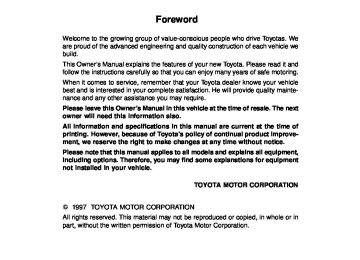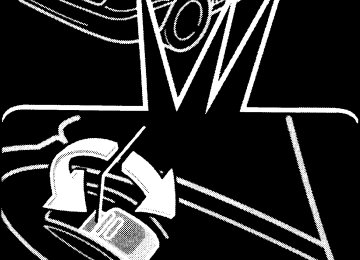- 2006 Toyota Camry Owners Manuals
- Toyota Camry Owners Manuals
- 1998 Toyota Camry Owners Manuals
- Toyota Camry Owners Manuals
- 2015 Toyota Camry Owners Manuals
- Toyota Camry Owners Manuals
- 2001 Toyota Camry Owners Manuals
- Toyota Camry Owners Manuals
- 2010 Toyota Camry Owners Manuals
- Toyota Camry Owners Manuals
- 2004 Toyota Camry Owners Manuals
- Toyota Camry Owners Manuals
- 2005 Toyota Camry Owners Manuals
- Toyota Camry Owners Manuals
- 1997 Toyota Camry Owners Manuals
- Toyota Camry Owners Manuals
- 2000 Toyota Camry Owners Manuals
- Toyota Camry Owners Manuals
- 2002 Toyota Camry Owners Manuals
- Toyota Camry Owners Manuals
- 2012 Toyota Camry Owners Manuals
- Toyota Camry Owners Manuals
- 1996 Toyota Camry Owners Manuals
- Toyota Camry Owners Manuals
- 2003 Toyota Camry Owners Manuals
- Toyota Camry Owners Manuals
- 2009 Toyota Camry Owners Manuals
- Toyota Camry Owners Manuals
- 2008 Toyota Camry Owners Manuals
- Toyota Camry Owners Manuals
- Download PDF Manual
-
5S-FE engine 1MZ-FE engine
Coolant type:
6.9 (7.3, 6.1) 9.1 (9.6, 8.4)
With ethylene-glycol antifreeze (Do not use alcohol type.)
BATTERY Open voltage* at 20 (cid:3)C (68 (cid:3)F):
12.7 V Fully charged 12.3 V Half charged 11.9 V Discharged
*: Voltage that is checked 20 minutes af- ter the key is removed with all the lights turned off
Charging rates:
5 A max.
Temperature range anticipated before next oil change.
L70010
CLUTCH Pedal freeplay, mm (in.): 515 (0.20.6) Fluid type:
SAE J1703 or FMVSS No. 116 DOT 3
MANUAL TRANSAXLE Oil capacity, L (qt., Imp. qt.):
5S-FE engine 1MZ-FE engine
Oil type:
2.6 (2.7, 2.3) 4.2 (4.9, 4.0)
Multipurpose gear oil API GL-4 or GL-5
Recommended oil viscosity:
SAE 75W-90
AUTOMATIC TRANSAXLE Automatic transmission
Fluid capacity (drain and refill), L (qt., Imp. qt.):
5S-FE engine Up to 2.5 (2.6, 2.2) 1MZ-FE engineUp to 3.5 (3.7, 3.1)
Fluid type: Automatic transmission fluid D-II or DEXRONIII (DEXRONII)
213
STEERING Wheel freeplay:
Less than 30 mm (1.2 in.)
Power steering fluid type: Automatic RON II or III
transmission
fluid DEX-
Differential
Fluid capacity, L (qt., Imp. qt.):
5S-FE engine 1MZ-FE engine
1.6 (1.7, 1.4) 0.85 (0.9, 0.7)
Fluid type: Automatic transmission fluid D-II or DEXRONIII (DEXRONII)
BRAKES Minimum pedal clearance when de- pressed with the pressure of 490 N (50
kgf, 110 lbf) with the engine running, mm (in.):70 (2.8)
Pedal freeplay, mm (in.):
16 (0.040.24)
Pad wear limit, mm (in.):
1.0 (0.04)
Lining wear limit, mm (in.):
1.0 (0.04)
Parking brake adjustment when pulled with the force of 196 N (20 kgf, 44 lbf):
69 clicks
Fluid type:
SAE J1703 or FMVSS No. 116 DOT 3
214
Tires Normal driving
kPa (kgf/cm2 or bar, psi)
For all loads including full rated loads For all loads including full rated loads
For reduced loads (1 to 4 passengers) For reduced loads (1 to 4 passengers)
Tire size
P195/70R14 90S P195/70R14 90S
P205/65R15 92S P205/65R15 92S
Front
210 (2.1, 30) 210 (2 1 30) 215/70R 16 99
215/70R 16 99Rear
210 (2.1, 30) 210 (2.1, 30)
220 (2 2 32) 220 (2.2, 32)
Front
210 (2.1, 30) 210 (2.1, 30)
200 (2 0 29) 200 (2.0, 29)
Rear
Wheel size
210 (2.1, 30) 210 (2.1, 30)
14 x 5.5JJ 14 x 5.5JJ
200 (2 0 29) 200 (2.0, 29)
15 x 6JJ 15 x 6JJ
Trailer towing
Tire size
P195/70R14 90S P205/65R15 92H
Front
210 (2.1, 30) 220 (2.2, 32)
kPa (kgf/cm2 or bar, psi) Rear
210 (2.1, 30) 220 (2.2, 32)
When driving under the above vehicle load conditions at sustained high speeds abve 160 km/h (100 mph), in countries where such speeds are permitted by-law, inflate the front and rear tires to 240 kPa (2.4 kgf/cm2 or bar, 35 psi) provided that it does not exceed the maxium cold tire pressure molded on the tire sidewall. Wheel nut torque, N⋅m (kgfm, ft⋅lbf): 104 (10.5, 77)
215
Fuses
Engine compartment
216
Engine compartment (Canada) Fuses (type A) 1. A/C 10 A: Air conditioning system 2. 10 A: Spare fuse 3. 15 A: Spare fuse 4. 30 A: Spare fuse 5. ALT-S 5 A: Charging system 6. HEAD (RH-HI) 15 A: Right-hand
headlight
7. EFI 15 A: Multiport fuel injection sys- tem/sequential multiport fuel injection system
8. HORN 10 A: Horn, theft deterrent sys-
tem
Engine compartment 9. HAZ 10 A: Emergency flasher 10.AM2 30 A: Gauge and meter, SRS air- bag system, Multiport fuel injection system/sequential multiport fuel injec- tion system, “IGN” and “ST” fuses
11.TEL 5 A: No circuit 12.HEAD (LH-HI) 15 A: Left-hand head-
light
13.RAD NO.1 20 A: Audio system
18.HEAD (RH-LO) 10 A: Right-hand
headlight
19.SEAT-HEA TER 20 A: No circuit 20.HEATER 10 A: Air conditioning sys- tem, rear window defogger, starting system
21.GAUGE 10 A: Gauges and meters, back-up lights, cruise control system, charging system, traction control sys- tem, daytime running light system, power windows, service reminder indi- cators and warning buzzers
22.WIPER 20 A: Windshield wipers and
washer
23.MIRROR-HEA TER 10A: Outside
rear view mirror defogger
24.ECU-IG 15 A: Cruise control system, anti-lock brake system, power anten- na, SRS airbag system, theft deterrent system, shift lock control system, trac- tion control system, daytime running light system, locking with wireless re- mote control system, multiport fuel in- jection system/sequential multiport fuel injection system
Instrument panel 14.DOME 7.5 A: Theft deterrent system, daytime running light system, clock, locking with wireless remote control system, ignition switch light, personal light, trunk light, electric moon roof lamp, interior light, vanity mirror light, door courtesy light, power door lock system
15.ECU-B 7.5 A: Cruise control system, anti-lock brake system, SRS airbag system
16.DRL NO. 2 5 A (vehicles sold in Can-
ada): Daytime running light system
17.HEAD (LH-LO) 10 A: Left-hand
headlight
25.IGN 5A: Gauges and meters, charging system, SRS airbag system, multiport fuel injection system/sequential multi- port fuel injection system
26.STOP 15 A: Stop lights, cruise control system, high-mounted stoplight, anti- lock brake system, shift lock control system, multiport fuel injection sys- tem/sequential multiport fuel injection system
17.TAIL 10 A: Parking lights, license plate lights, tail lights, front side mark- er lights, daytime running light system, multiport injection system/se- quential multiport fuel injection system 28.POWER-OUTLET 15 A: Power outlet 29.OBD 7.5 A: On-board diagnosis sys-
fuel
tem
fuel
30.FOG 15 A: No circuit 31.STARTER 5 A: Gauges and meters, multiport injection system/se- quential multiport fuel injection system 32.DOOR 25 A: Power door lock system, theft deterrent system, fuel filler door control system
217
42.PWR 30 A: Power window control sys-
tem, power seat, electric moon roof
43.AM1 40 A: Head lamp cleaner Fuses (type C) 44.ALT 100 A: “RDI FAN”, “CDS” fuses 45.ABS 60 A: Anti-lock brake system
33.PANEL 7.5 A: Gauge and meter, au- dio system, cigarette lighter, glove box light, clock, instrument panel light con- trol, service reminder indicators, air conditioning control panel lights, ash- tray light, emergency flasher, seat heater control system, daytime run- ning light system, rear window defog- ger, electronically controlled automat- ic transmission system
34.TURN 7.5 A: Emergency flasher 35.RAD-NO. 7 7.5 A: Audio system,
power
36.CIG 15 A: Cigarette lighter, shift lock control system, power rear view mirror controls, theft deterrent system, pow- er door lock system, SRS airbag sys- tem, outside rear view mirror defogger, air conditioning system
Fuses (type B) 37.CDS 30 A: Electric cooling fans 38.RADI FAN 30 A: Electric cooling fans 39.MAIN 40 A: “HEAD (RH-HI)”, ”head
(rh-lo)” FUSES
40.HTR 50 A: “AM1”, “A/C” fuses 41.DEF 40 A: Rear window defogger
218
Part 9
REPORTING SAFETY DEFECTS FOR U.S. OWNERS AND UNIFORM TIRE QUALITY GRADING (cid:1) Reporting safety defects forU.S. owners
(cid:1) Uniform tire quality grading
Reporting safety defects for U.S. owners If you believe that your vehicle has a defect which could cause a crash or could cause injury or death, you should immediately inform the Na- tional Highway Traffic Safety Ad- ministration (NHTSA) in addition to notifying Toyota Motor Sales, U.S.A., Inc. (Toll-free: 1-800-331-4331). If NHTSA receives similar com- plaints, it may open a investiga- tion, and if it finds that a safety de- fect exists in a group of vehicles, it may order a recall and remedy campaign. However, NHTSA can- not become involved in individual problems between you, your deal- er, or Toyota Motor Sales, U.S.A., Inc.
To contact NHTSA, you may either call the Auto Safety Hotline tollfree at 1-800-424-9393 (or 366-0123
in Washington D.C. area) or write to: NHTSA. U.S. Department of Transportation. Washington D.C. 20590. You can also obtain other information about motor vehicle safety from the Hotline.219
Warning: The temperature grades for this tire are established for a tire that is proper- ly inflated and not overloaded. Excessive speed, underinflation, or excessive load- ing, wither separately or in combination, can cause heat buildup and possible tire failure.
Uniform tire quality grading This information has been prepared in ac- cordance with regulations issued by the National Highway Traffic Safety Adminis- tration of the U.S. Department of Trans- portation. It provides the purchasers and/ or prospective purchasers of Toyota vehicles with information on uniform tire quality grading. Your Toyota dealer will help answer any questions you may have as you read this information. DOT quality grades—All passenger vehicle tires must conform to Federal Safety Requirements in addition to these grades. These quality grades are molded on the sidewall. Treadwear—The treadwear grade is a comparative rating based on the wear rate of the tire when tested under con- trolled conditions on a specified govern- ment test course. For example, a tire graded 150 would wear one and a half (1-1/2) times as well on the government course as a tire graded 100. The relative performance of tires depends upon the actual conditions of their use, however, and may depart significantly from the norm due to variations in driving habits, service practices and differences in road characteristics and climate.
220
Traction A, B, C—The traction grades, from highest to lowest, are A, B, and C, and they represent the tire’s ability to stop on wet pavement as measured under controlled conditions on specified govern- ment test surfaces of asphalt and con- crete. A tire marked C may have poor trac- tion performance. Warning: The traction grade assigned to this tire is based on braking (straight ahead) traction tests and does not include cornering (turning) traction. Temperature A, B, C—The temperature grades are A (the highest), B, and C, rep- resenting the tire’s resistance to the gen- eration of heat and its ability to dissipate heat when tested under controlled condi- tions on a specific indoor laboratory test wheel. Sustained high temperature can cause the material of the tire life, and ex- cessive temperature can lead to sudden tire failure. The grade C corresponds to a level of performance which all passenger car tires must meet under the Federal Mo- tor Vehicle Safety Standard No. 109. Grades B and A represent higher levels of performance on the laboratory test wheel than the minimum required by law.

